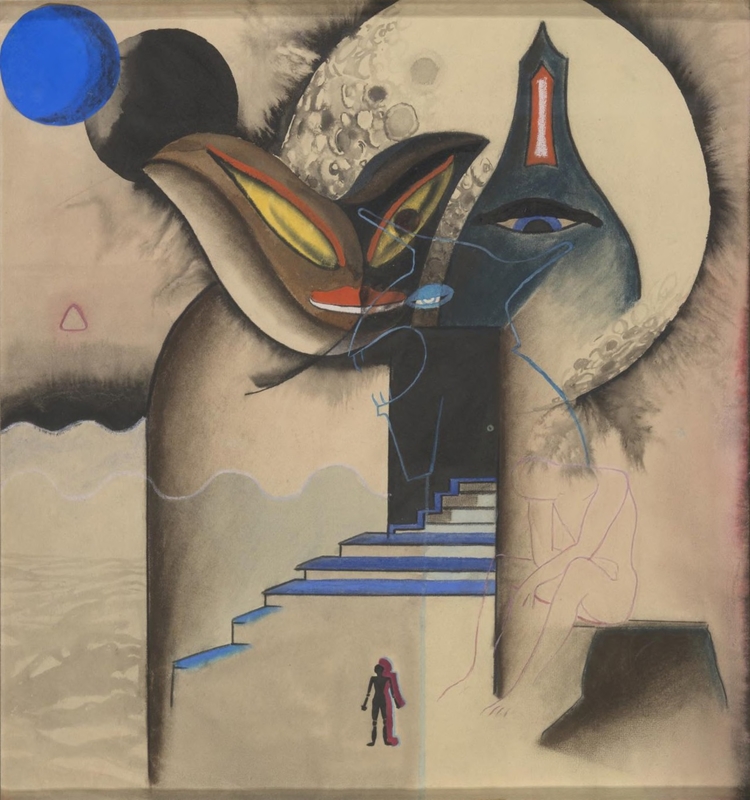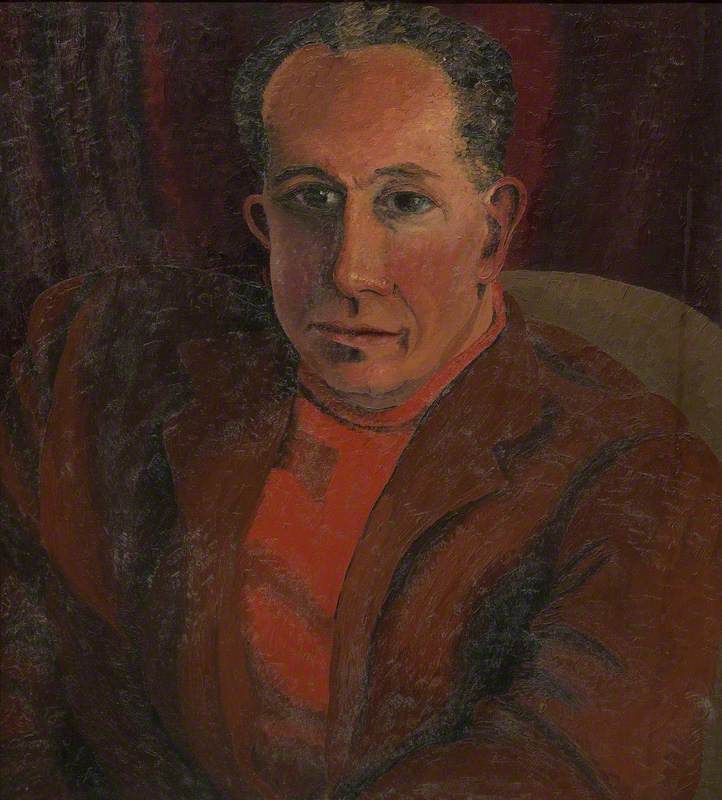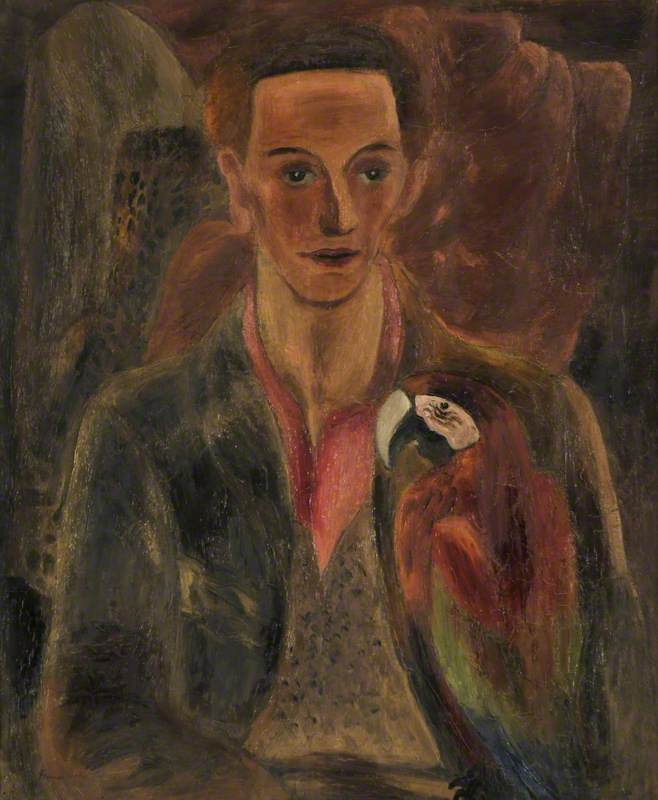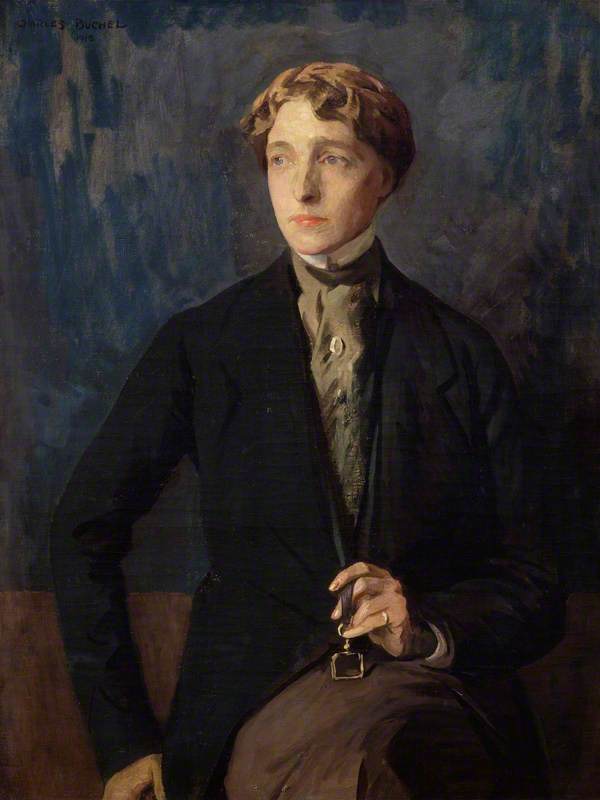Between 6th July and 3rd November 2024, Gainsborough's House is presenting a comprehensive exhibition of artworks showcasing two artists, Cedric Morris (1889–1982) and Arthur Lett-Haines (1894–1978). Morris is the more celebrated today due to the success of his flower paintings and one of the aims of the exhibition is to make the work of Lett-Haines better known.
Morris, Lett-Haines and Rubio the parrot
c.1929–1936, photograph by unknown artist 
Famously meeting on Armistice Night, 1918 the two were together for 60 years, partners in love and art, and while both absorbed the European Modernist influences of the 1920s, only Morris had a consistent artistic output. After the founding of the East Anglian School of Painting and Drawing in 1937, first in Dedham and then at Benton End, Suffolk, Lett-Haines focused on promoting Morris's career and running the School, only resuming his art in his later years.
The exhibition has several sections, starting from the early experimental works produced while they lived in Paris from 1920 – mixing with avant-garde artists and writers – to portraits produced by Morris for his 1938 show with Peggy Guggenheim, to the 'protest paintings' which demonstrated Morris's dislike of the destruction of wildlife. The flower paintings created while they lived at Benton End are interspersed with the Surrealist imaginings of Lett-Haines, comprising anthropomorphic shapes and forms of animals, plants and humans.
Morris was fascinated by the human face and created a large number of portraits throughout his career, many of which were donated to Gainsborough's House. His self portrait from the National Portrait Gallery is on display. Morris, aged here about 41, has a pensive gaze. His love of nature is shown by his immersion in the background landscape of trees and the meandering river which echoes the curve of his face. Roger Fry, art critic who introduced Post-Impressionism to Britain, wrote in 1925, 'he really charmed me…all temperament and sensibility and genuine stuff and très fin and not a fool anywhere and I liked him'.
There is also a portrait of Lett-Haines by Morris, in which Lett-Haines is shown with a piercing gaze, looking out of the canvas.
Lett-Haines
1928, oil on canvas by Cedric Lockwood Morris (1889–1982) 
Both artists experimented in post-war Paris with Cubism, Abstraction, Surrealism and Futurism. An example of this period is Morris's Experiment in Textures. Here we see an abstract work of different textures and colours radiating from the centre, in which Morris is seeking to give a rhythm and form to nature to celebrate its mass and volume. It was exhibited at the Arts League of Service in 1924 in London.
The Escape
1931, Indian ink & watercolour on paper by Arthur Lett-Haines (1894–1978) 
Lett-Haines's work absorbed more of a Surrealist strand, such as The Escape. This work is a vibrant scene of several moving figures, shown dancing, kneeling and stretching, all set in a dreamlike world with the blue figure on the left in a dominant position. Accompanying the human figures are a bird in flight, a squatting leopard, and a skulking serpent-creature. The backdrop of a glowing red sky references fire or an apocalyptic vision, suggesting the reason for the escape, whether actual or metaphorical.
Morris struggled to attract portrait commissions due to the uncompromising nature of his likenesses but he did have a wide network of friends and indeed pupils from the School to call upon. The exhibition presents his portrait of Lucian Freud. Freud, one of the twentieth century's most celebrated artists, attended the East Anglian School of Painting and Drawing at Dedham, and later Benton End, where this portrait was painted when Freud was 19. Freud later wrote, 'Cedric taught me to paint and more important to keep at it. He did not say much but let me watch him at work'.
Angus Wilson was a leading novelist of post-war Britain, and his wartime portrait is also exhibited. His works such as Anglo-Saxon Attitudes (1956) and The Middle Age of Mrs Eliot (1958) were among the first British literary novels to portray homosexual characters as the norm. A friend of Morris and Lett-Haines, he is reputed to have introduced the idea of breeding irises to Morris.
As mentioned, Morris is celebrated for his flower painting, particularly those of irises and still lives, which are featured in the exhibition. Morris moved from painting large masses of flowers to carefully positioned compositions.
Iris Seedlings shows a jug filled with irises obscuring what appears to be a closed window overlooking rolling hills and a bright blue sky. But on closer inspection, the background seems to be a framed painting with Benton End nestling in the landscape, and this suggests a confined environment rather than the natural landscape – indicative of the claustrophobia caused by the confinements of wartime existence.
The vase allows the flowers to fall outwards, actually displayed as if they were still standing in a garden and were no doubt painted from life. The extensive lower garden at Benton End was filled with irises, about 1,000 seedlings each year, and 1943 produced some of Morris's best-ever seedlings, the result of careful experimentation with different breeds.
The Eggs shows how Morris appropriated subjects from everyday material. It was painted by him from a high vantage point in a bare but brightly coloured interior. Colour is used to direct our attention to the eggs sitting on a bright pink stool in a ceramic brown striped dish. The dish is slightly off centre, the stool cropped in the foreground to give a tilting perspective, framed by a yellow open door which opens into an adjacent room with a second closed door, again creating a slight sense of entrapment.
Morris occasionally used still lives as allegories for world events, as in Yalta. The title refers to the name of the Second World War conference between Churchill, Stalin and Roosevelt in February 1945 in which the victorious powers decided upon the division of Europe in the event of the expected defeat of Nazism.
Jeunes filles aux fleurs
1935, watercolour and gouache on paper by Arthur Lett-Haines (1894–1978) 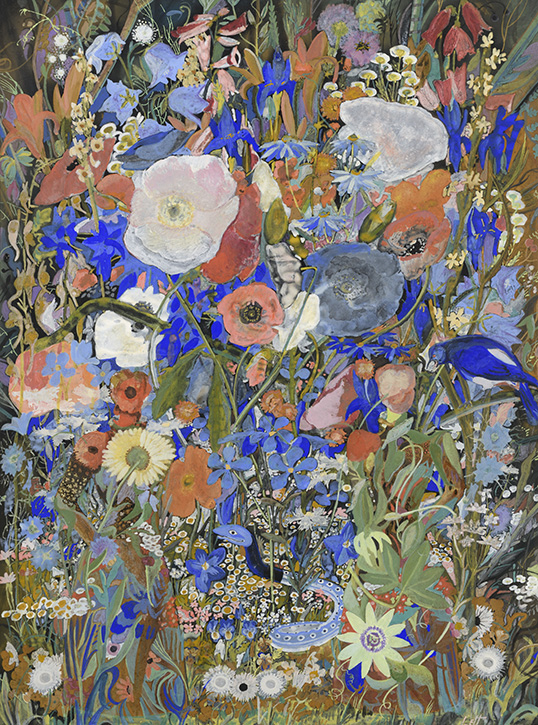
Lett-Haines also painted the natural world and Jeunes filles aux fleurs shows a glorious array of summer flowers with red poppies, daisies and blue campanulas interspersed with birds, which are camouflaged by the bright flowers. Lurking in the foreground, again hidden by the flora, is a blue snake, coiled and ready to spring to upset this garden of Eden. This year was intensely productive for Lett-Haines in that he exhibited 32 watercolours and oils and six drawings for an exhibition at Picture Hire.
Vue d'une fenêtre
1967, watercolour on paper by Arthur Lett-Haines (1894–1978) 
Likewise, Vue d'une fenêtre by Lett-Haines is a vision of the natural world in the shape of the six-window pane frame of his bedroom window at Benton End. The artist creates an imaginary world of creatures and foliage outside his window to contrast with the tended beds cultivated by Morris outside.
In the same way that Morris studied flowers with meticulous attention, he also observed and researched birds, painting them almost as if they had acquired human characteristics. In Peregrine Falcons, he simplifies the lines to reduce the forms. The yellow talons of the right-hand bird are highlighted with the orange-speckled eggs. Next to these protected eggs, in the lower foreground, is a duck's skull: a reminder of predators in nature.
Morris is also represented in the exhibition with his 'protest paintings' – one of which is Landscape of Shame. This work was painted to highlight the fate of birds (and often their eggs) killed by pesticides and crop sprays used in intensive agricultural practices which were being increasingly deployed in the 1950s. It shows dead or dying birds on an open expanse of brown earth under a blue sky. At least twenty types of birds are shown, with a blue-black rook and a grey-black moorhen in the foreground. Behind the rook are, from left to right, a fieldfare, chaffinch and in the centre a male partridge with dark red markings, a female blackbird and woodpigeons. To the right is a thrush and a sparrowhawk. Directly above the partridge are black-headed white gulls.
Morris was outraged by the consequences of this chemical poisoning of the farming landscape around him but it was not well understood until much later. It was eventually (after this painting was produced) discovered to be caused by seed corn coated with aldrin or dieldrin to stop pests.
Pour decouvrir le mystère de la femme, tirez le masque
1966, mixed media by Arthur Lett-Haines (1894–1978) 
In the mid-1950s, when the demands of the School diminished, Lett-Haines resumed his painting and developed a unique style of British Surrealism – his imagination going on dreamlike journeys with fantastic, sometimes menacing shapes. Pour decouvrir le mystère de la femme, tirez le masque is a mechanical mixed media image in which a strut allows the viewer to pull the mask back and forth.
Angry Humble
1965, mixed media by Arthur Lett-Haines (1894–1978) 
The exhibition closes with Lett-Haines's 'petits sculptures' such as Angry Humble. It is a tiny sculpture made by Lett-Haines from a mixture of materials, crab shells, chicken bones, pencil shavings and matchsticks rooted in plaster, some with glass eyes. It is fitting that the exhibition closes on these Surrealist creations, redolent of an underdeveloped strand of British art which blossomed uniquely in Suffolk in the later half of the twentieth century – presenting a contrast to the more accessible artworks of Morris.
Dr Patricia Hardy, Curator at Gainsborough's House
'Revealing Nature: The Art of Cedric Morris and Lett-Haines' is showing at Gainsborough's House in Suffolk from 6th July until 3rd November 2024
